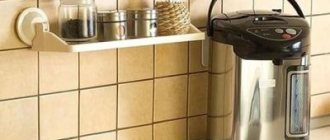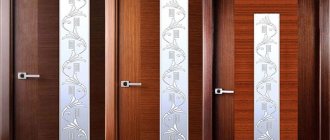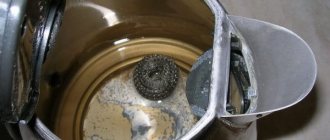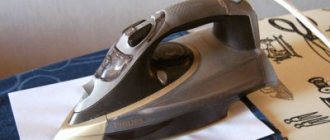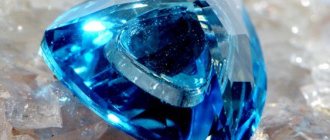For which teapots is it not suitable or suitable?
The market is filled with different teapots. Even in one family, several types of equipment can be used at once, and accordingly, care can be different. Cleaning a kettle from scale with citric acid may not be suitable in every case. There are materials that can deteriorate when interacting with an acidic environment.
Not suitable:
- Enameled teapots cannot be cleaned with lemon or other acid-containing products. The enamel becomes thinner and the equipment will quickly become unusable. In this case, soda is more suitable for cleaning. A tablespoon of the product should be dissolved in water, boiled and drained, and then wash the product. Folk remedies include peeling apples and pears. Simply place the fruit scraps in a kettle of water and boil them. A small amount of acid washes away the scale. The method works only for minor contamination;
- Plastic electric ones - here you need to be more careful with acids and use more gentle products. If you don't know how to clean an electric kettle, try making a weak solution of citric acid and leaving it for a couple of hours. The appearance of such products is tidied up using soda dissolved in water. You can make a thin paste, apply it to the stains and after a while, gently rub. And, of course, no vinegar or direct aggressive effects of acids - plastic does not like this. It should be noted that plastic kettles are cleaned much faster than their metal or enamel counterparts.
Fits:
- Metal ones can be easily cleaned with lemon or vinegar. You can boil an acid solution in them, this will not affect the quality of the device. Baking soda diluted in water is also suitable for washing. Do not use abrasive materials, only soft brushes, sponges and cloths;
- Electric ones made of heat-resistant glass - the use of acid will not only quickly clean such a kettle, but also give it shine. Usually there is no sediment left on the glass, but the heating bottom may be dirty. Boil water with acid, rinse well and wipe from the inside. Citric acid will help remove traces of dirt from the outside of the electric kettle. And of course, no hard brushes or metal sponges;
- Thermopot is a very convenient thing to have in the house, but there are difficulties in cleaning it due to the structure and weight of the thermopot. But here citric acid comes to the rescue. It is more effective than baking soda and does not have a strong odor like vinegar. You need to pour a packet of acid into the thermopot and boil the solution. Drain the water and wipe the walls and bottom with a soft cloth. A final boil can be carried out.
Enameled
Plastic
Metal
Electric glass
Thermopot
Additional ways to clean your kettle
To effectively clean a stainless metal surface, you can also use other cleaning methods.
Products used for cleaning include:
- toothpaste;
- soda;
- vinegar.
How to use these recipes correctly?
Using vinegar and soda
You can also carefully and effectively clean the outside of the kettle if you boil it in a solution of vinegar and soda:
- Pour 3 tablespoons of soda into a container with a large diameter, then add the same amount of vinegar. Mix the mixture thoroughly and pour in a liter of water. If this volume of liquid is not enough to completely immerse the device, the quantity of products must be increased.
- It is necessary to boil the kettle in the solution for 4–5 minutes, after which you need to wait for it to cool completely.
- Now we wash the metal with cool water using a rag or sponge.
- Then be sure to dry the container with a towel.
It is important to note that this method is considered the most effective, but its use can cause problems for the skin, so this cleaning option requires gloves.
Preventing the formation of limescale
Practice shows that scale forms when using any water. However, there is always the opportunity to slow down this process and make cleaning the kettle a rarer and easier procedure.
To do this, it is recommended to use purified water for boiling. It contains less salts. In addition, it is very useful to let the water stand for 24 hours. It is also advisable not to leave unused water in the kettle and pour it out immediately after drinking tea.
The walls of the device must be regularly wiped with a soft, soapy sponge. This helps in time to remove the salt layer that has not yet stuck to the surface.
When purchasing a new kettle, it is recommended to give preference to modern models in which the heating element is coated with a special material. It prevents excessive scale deposits and thereby protects the boiler from damage and increased energy consumption.
Folk recipes
Using the means and products that are available in the household, you can solve the issue of scale that has formed in an enamel kettle.
The need to remove it is due to the following circumstances:
- health hazards resulting from ingestion of limescale particles;
- deterioration of thermal conductivity and, as a result, the need for more time to boil;
- deterioration in the taste of drinks;
- enamel damage.
Simple cleaning using a washcloth and dishwashing detergent does not remove scale.
How to remove with citric acid?
Citric acid is not only a food product, but also a means that allows you to remove scale from various surfaces (from kettles to washing machines). The advantage of cleaning using this method is its high efficiency and lack of toxicity.
Procedure:
- Pour water. There should be enough of it to cover all areas affected by scale.
- Add citric acid (3-5 tbsp).
- Boil.
- Remove from heat.
- After complete cooling, rinse.
To wash off the remaining acid, it is advisable to boil clean water in it and pour it out. Read more here.
Vinegar
The acid contained in vinegar reacts when it comes into contact with lime. As a result, the hard scale breaks down, becomes loose, and is easy to remove.
Cleaning procedure:
- pour water into the kettle;
- add vinegar (1 tbsp);
- stir;
- let stand for half an hour;
- boil;
- let simmer for 10 minutes;
- set aside from heat;
- drain the water and vinegar;
- rinse the container.
It is recommended to clean with this method with good ventilation, as vinegar emits a strong odor when heated.
You can find out more about descaling your kettle with vinegar here.
How to clean with soda?
Regular baking soda can also be used to clean the kettle from plaque. With this method, the cleaning procedure is as follows:
- Pour water into the kettle 2/3 full.
- Add baking soda (1 tbsp).
- Boil for half an hour.
- Cool.
- Drain.
- Rinse under running water with a washcloth.
Read more about descaling your kettle using baking soda here.
Sweet carbonated drinks
Carbonated drinks like Sprite can also be used to remove scale. This application has a limitation - the amount of liquid poured should not fill the kettle more than ½ volume.
Application:
- pour a drink;
- boil;
- let stand for half an hour;
- drain;
- rinse with water.
It is advisable to use light, almost transparent carbonated drinks, since dark, rich colors can stain the enamel.
You can read more in this article.
Apple (potato) peelings
The fruit acids contained in apple peelings can serve as a good descaling agent in a kettle. For this:
- the peelings are folded inside the container, filling it ½ full;
- fill with water up to 2/3 of the volume;
- bring to a boil and leave to simmer over low heat for an hour;
- cleaning is removed, water is drained;
- The bottom and walls of the inner surface are washed with a sponge.
In addition to apple peelings, you can also use pear or potato peelings.
Oxalic acid
This product allows you to clean scale by loosening lime deposits. Application:
- Fill the kettle with water.
- Add 1 large spoon of acid.
- Boil.
- Leave to stand for 3-4 hours.
- Drain the solution.
- Rinse the kettle.
Using fresh sorrel is not as effective as using acid.
Pickled cucumber brine
Undiluted cucumber pickle is suitable for descaling. It's easy to use:
- Pour the brine into the kettle.
- Boil.
- Remove from heat.
- Let stand until completely cool.
- Drain the brine.
- Rinse the inside.
If the specific smell persists, boil again with clean water and drain again.
How and with what you can descale an electric kettle at home
Scale formation in electric kettles occurs no matter what kind of water you use, even if it is well purified or from mountain springs, it still contains salts, which is why plaque appears on the heating element and the inner surface of the electric kettle when it is constantly used. use.
The quality of water greatly influences the rate of scale formation, therefore, using low-quality water for boiling (untreated, unfiltered), a large layer of scale will soon form in the kettle, which can lead to premature damage to the household appliance, and will also increase the boiling time of water (scale has a low thermal conductivity and acts as insulation between the water and the heating element).
It will be very difficult to remove scale from an electric kettle with plain water and a dish sponge; even dishwashing detergent will not help much. In this case, it is best to use effective special descaling products or time-tested folk methods that will help remove scale from an electric kettle without unnecessary waste and with minimal time and effort.
Cleaning the electric kettle from scale and white deposits inside can be done using the following improvised means:
- Lemon acid.
- Table vinegar 9%.
- Baking soda.
- Potato and apple peelings, as well as brine from canned cucumbers and tomatoes (these products are practically not used anymore, since they are not very effective and specific, so we will not consider them in the article.
The means listed above have been used for a long time by many housewives to combat scale not only in electric kettles (metal, plastic and glass), but also to remove scale in other household appliances, so we will consider further in more detail what needs to be done before starting to clean the kettle and How to use each descaler.
Preparing to descale an electric kettle
- It is better to clean an electric kettle when none of your family members are going to use it in the next few hours (so as not to accidentally pour water with a cleaning agent into your tea or coffee), and it is better to warn them in advance that the kettle cannot be used.
- To remove scale from an electric kettle, you do not need to use special brushes and metal brushes, which can damage the inner surface and the heating element in the kettle. When cleaning, the most commonly used descaling agent and, in some cases, an ordinary soft dish sponge are sufficient.
- The process of descaling an electric kettle can be combined with its external washing, and the sequence of its complete cleaning does not matter.
- After using special chemical descaling agents, as well as ordinary improvised ones, it is always necessary to thoroughly rinse the inside of the electric kettle, as well as boil and drain ordinary clean water in it several times, so that all remnants of the product used are removed and do not end up in tea or coffee.
After familiarizing yourself with the basic rules and precautions, you can proceed directly to the cleaning itself, choosing one of the methods suggested below on how to get rid of scale in an electric kettle at home (the given methods are arranged in the following sequence: from the most effective and simple to the least effective, not taking into account special chemicals at the end of the article)
How to clean a glass teapot
A simple, but no less effective method for removing calcified deposits is the use of sprite.
This carbonated drink helps to clean the kettle, including old scale. To do this, just pour a glass of Sprite, then water and boil this solution for 15 minutes.
However, the described method is not suitable for electric kettles. To descale a glass electric kettle, the following methods are recommended.
Fast removal of deposits
Table vinegar helps to quickly descale a glass electric kettle.
This liquid fights well against various deposits and does not have a toxic effect.
To remove scale, you need:
- Pour out all the water from the device.
- Mix water and table vinegar in equal proportions.
- Pour the solution into an electric kettle and bring to a boil.
- Let the mixture stand for at least two hours, turning off the kettle.
- Wash the inner walls with a damp sponge.
You can replace table vinegar with apple cider vinegar. In this case, the product must be diluted with water in a ratio of 4:1. This method is less effective than the previous one. Therefore, to remove old plaque in a glass teapot, the procedure must be repeated several times.
Safe cleaning
Lemon juice is often used as a substitute for table vinegar.
The acid contained in this liquid dissolves calcified deposits.
To descale glass teapots you will need:
- Mix 1-1.5 tbsp. l. acid and a liter of water. You can also squeeze the juice from one lemon.
- Add the juice or solution to the kettle and fill it with water to the brim.
- Boil the mixture, pour out and rinse the kettle with water.
- Boil clean water and rinse again.
A mixture of 20 drops of lemon essential oil and a liter of water demonstrates a similar effect. This solution should be sprayed onto the walls of a glass teapot and left for a few minutes. Then the device must be cleaned with a toothbrush.
Removing fresh plaque
Soda is good at cleaning a glass teapot from fresh scale.
To remove limescale, it is enough:
- Mix a teaspoon of baking soda and 500 ml of water.
- Boil the solution and let stand for 10 minutes.
- Drain the solution and repeat the procedure.
If the plaque appeared a long time ago, the following method is used:
- Water is brought to a boil and then mixed with 3 tbsp. l. soda
- The solution is kept for half an hour, after which it is boiled.
- The soda solution is drained, and a mixture of water and 3 tbsp is poured into the kettle. l. vinegar.
- The vinegar solution is brought to a boil and left for half an hour.
- The remaining limescale deposits are removed with a soft sponge, after which the glass container is rinsed.
The indicated proportions are taken for a glass teapot with a volume of 2 liters. To enhance the effect of cleaning at home, after completing the procedure, it is recommended to boil a mixture of water and citric acid.
Specialized means
To clean the kettle from plaque, you can use specialized anti-scale products. The latter include Glutoclean brand products. This product is highly effective, but is expensive compared to other similar cleaners. The price of Glutoclean reaches 480 rubles.
This product contains organic acids that quickly and without harm to health remove plaque. This product is suitable for cleaning glass ceramics and a number of other materials. In addition to scale, Glutoclean removes old salt deposits and metals. This product comes in the form of a highly concentrated liquid, which must be used to wipe the internal walls.
To quickly descale a glass teapot, you can treat it with Antiscale. This product is produced in the form of disposable bags, the prices of which do not exceed 20 rubles. Antinakipin contains adipic and sulfamic acids. Because of these components, after using the product, it is recommended to boil the kettle twice and then drain the water.
Cillit brand products are considered universal cleaners for glass containers. This liquid not only removes scale, but also creates protection against new deposits and bacteria for 7 days. The product contains oxalic acid and amphoteric surfactants. Because of these components, a glass teapot cannot be used immediately for its intended purpose after cleaning. The device must be thoroughly rinsed. Cleaning Cillit costs no more than 200 rubles.
Scale appears on the inner walls of a glass teapot, regardless of the type of water used. To remove such plaque, various organic acids (acetic, citric) or specialized products are used.
Folk remedies for descaling
To remove scale from a stainless steel kettle, it is recommended to use home remedies.
Those who are susceptible to allergic reactions should be especially careful in their selection. Such consequences can be caused by household cleaners, which are advisable to use only for old scale that has not been removed for a long time. Traditional methods can deal with light deposits without difficulty or harm to both the teapot and your health.
Cleanliness made easy with citric acid
Citric acid is a cleaning agent that effectively copes even with old lime deposits.
Solutions based on citric acid have a gentle effect on scale by breaking it down. The surface is not damaged.
Take:
- water – 1 liter;
- citric acid – from 10 to 20 g (depending on the degree of plaque).
Instructions:
- Pour water into a stainless steel kettle, add citric acid - no need to stir. During the boiling process, the lemongrass crystals will dissolve.
- Bring the water to a boil. After turning off, leave for half an hour/hour to act. How long to leave depends on the degree and amount of deposits.
- Drain the liquid, wait until it cools down and wash with a soft sponge and detergent.
- Pour in clean, preferably filtered water, and send it to boil again.
- After boiling, drain the water. Do not use for drinking!
A general rule for all cleaning methods: after completing the procedure, you need to boil clean water again. This will remove any remaining cleaning compound from the surface of the kettle.
Vinegar - from old and minor plaque
Vinegar is the second most effective home remedy after citric acid.
Both the essence and table vinegar will help remove scale from a stainless steel kettle. Old plaque can only be dealt with by essence, but table vinegar can also cope with a thin layer of young scale. It is worth understanding that proportions must be observed.
For 3 liters of water you usually take:
- or 2-3 teaspoons of essence;
- or 50 ml of 9% vinegar.
The method of cleansing with vinegar has only one drawback - a sharp, pungent odor. Inhalation of vapors can cause burns to the mucous membranes. Therefore, make sure that the room where cleaning will be carried out is well ventilated.
Instructions:
- Mix water and vinegar selected depending on the degree of contamination.
- Pour the solution into the kettle.
- Place on the stove, close the lid and bring to a boil.
- Remove the cover to check the effectiveness of cleaning. The kettle should be removed from the stove when the scale begins to come off.
- Let the solution finish what it started by waiting half an hour.
- Rinse, refill with water and boil.
- After boiling again and draining the liquid, let the kettle dry.
Vinegar, as a cleaning agent, is only suitable for stainless steel coatings. Application to electric kettles is unacceptable.
Soda - simple, affordable and effective
To get rid of salt deposits in a stainless steel kettle at home, you should turn to soda.
Its effectiveness has been proven over the years - alkali easily and quickly breaks down only a thin layer of scale. Therefore, soda is recommended for preventative cleaning once a week.
You will need:
- water – 3 l;
- soda – 6 tsp. (with a slide).
Steps:
- Pour the indicated volume of liquid into the kettle.
- Add soda.
- Bring to a boil, remove from heat.
- Leave to cool so that the baking soda solution helps clear the scale. The process will take about 2 hours. The alkaline reaction of soda and water is not strong, but safe, so it takes time.
- After assessing the result, proceed to cleaning with a sponge and rinsing with water.
The use of soda in dry form on a metal surface is unacceptable. Abrasive particles can cause scratches, in which salt particles will subsequently accumulate, leading to the formation of new layers of scale.
Instructions for cleaning at home
Algorithm of actions:
- The kettle is half filled with water.
- Add 2 tbsp. baking soda (per liter of water)
- Bring the water to a boil, let the soda solution simmer for thirty minutes over low heat.
- Afterwards, remove the kettle from the heat and leave it alone for two hours.
- Remove softened layers of limescale (you can use a hard sponge).
- Rinse dishes with clean water.
When using baking soda to clean an eclectic kettle, the boil setting must be turned on at least three times.
With vinegar
Descaling with vinegar and soda is an effective method, but not very suitable for plastic, metal or ceramic appliances. It is used in the most extreme cases, when other methods have not helped achieve the desired cleanliness result.
Algorithm of actions:
- the kettle is filled with water, table vinegar and soda are added (based on 2 liters of water - 100 ml of vinegar solution and 1 tablespoon of soda powder);
- The dishes are left to soak for at least six hours (preferably overnight);
- after that, the softened limescale deposits are removed with a sponge;
- Rinse the kettle thoroughly, changing the water several times.
Alternatively, instead of vinegar, you can use vinegar essence (no more than 1 tablespoon per liter of water). Having boiled the water, leave it to cool, after which the deposits are removed with a hard sponge.
With salt
At the same time, salt and soda will help get rid of limescale, both from the inside and the outside.
Algorithm of actions:
- Prepare a cleaning solution. To do this, salt and soda are dissolved in water at the rate of 2 tbsp. dry ingredients per 1 liter of water.
- The kettle is filled with the prepared solution, after which it is lowered into a wide basin so that the composition covers it on all sides.
- The soda-salt solution is boiled for half an hour, after which the dishes are removed from the heat, cooled, and rinsed with cold water.
After cleaning with salt, the dishes must be thoroughly wiped with a dry towel. Otherwise, whitish stains will remain on the surface.
With citric acid
Citric acid and soda will help quickly remove limescale from the walls of electric and glass teapots.
It's simple:
- fill the dishes with water, add a bag of citric acid powder and baking soda (calculation: 1 tablespoon of dry ingredients per 1 liter of liquid);
- boil water with citric acid and soda for at least ten minutes, after which the kettle is left alone for at least one hour;
- water, along with dissolved particles of limescale, is poured into the sink.
The cleaning method using citric acid is ineffective for old stains.
With lemon and acetic acid
A solution of acetic acid in combination with slices of fresh lemon and soda is “heavy artillery” in the fight against old limescale deposits.
Algorithm of actions:
- 4 tablespoons are diluted in a liter of water. vinegar and a few slices of fresh lemon, 2 tbsp. baking soda.
- The prepared solution is poured into a kettle and boiled for thirty minutes
- Softened layers of scale are removed with a soft sponge.
After the walls of the kettle are cleared of scale, clean water is additionally boiled in it (preferably twice).
Homemade recipes for cleaning the surface of the kettle
How to clean the outside of a stainless steel kettle? The appearance of scale on the outside of the kettle and other kitchen utensils is an inevitable and unpleasant process. But what to do if unsightly and hard stripes have formed on the surface of the device? Today there are a large number of recipes that help get rid of unpleasant scale. They are caused by laundering the stainless metal with the help of various products and chemical components that are used to generously pour over the kettle.
It is important to note that these methods are not suitable for cleaning electrical appliances!
So, how to remove scale from a stainless steel kettle - various options for cleaning the metal.
Application of citric acid
To clean the kettle with citric acid, you can use a cotton pad or swab:
- moisten it in a solution of citric acid (a liter of water per bag of lemon);
- then apply to the scale;
- We wait until the unpleasant coating completely dissolves.
You can also use a highly absorbent rag to wrap the kettle in to quickly clean the deposits.
If you don’t have time to clean, you can dip the kitchen appliance in a solution of citric acid, but in this case you shouldn’t keep the kettle in lemon liquid for a long time, as this may damage the inner layer (usually it becomes rough and begins to gradually separate when boiling water ). If the plaque does not disappear from the surface, it is allowed to repeat the manipulation - only in this case it is recommended to increase the amount of acid taken. If desired, replace the lemon juice with the juice of one lemon.
After cleaning, rinse the kitchen appliance thoroughly using detergent. To evaluate the result of the work, after washing the stainless surface will need to be wiped with a towel.
Typically, citric acid clears newly formed plaque. Therefore, if the metal has not been descaled for a long time, it should be treated with stronger cleaning compounds.
Using Baking Soda When Cleaning
This method is considered the simplest and most accessible to everyone. To implement it, you first need to heat the kettle and then place it on the sink. Now you need to take out the baking soda, pour it onto a damp sponge or rag, and then gently wipe the surface. If the plaque does not come off, you need to take more soda and turn the sponge over to the hard side, which can clean complex stains. After cleaning, the kettle is washed with soapy water and then dried to evaluate the result. There are some precautions:
- It is important to note: heating the kettle is required so that the deposits come off the walls of the kitchen appliance faster. However, in this case, you need to be careful not to get burned during cleansing.
- It’s also worth noting that baking soda is considered an abrasive, so you shouldn’t scrub the metal too hard to avoid scratching the surface.
Usually, soda cleans stainless metal well, since alkali easily corrodes scale and greasy marks.
The second way to use soda
This method is considered more effective, since when it is performed, the kettle will be boiled in a soda solution, which will provide more gentle and high-quality cleaning. Therefore, this cleaning method is best used if the metal is heavily soiled. Take a large container so that the kettle can fit completely into it. After this, put in it as many spoons of soda as liters needed to completely immerse the device. Then put the container on gas, lower the kettle into it and boil over medium heat for 30 minutes.
It is important to note that when performing this option, the plaque will not leave the walls on its own, so it will need to be removed with a brush or rough cloth after the water has cooled. Then the kettle is wiped dry to evaluate the quality of cleaning. If the kitchen appliance is too dirty, you can add 1-2 tablespoons of detergent to the water.
These cleaning products can only be used once a week!
The most popular methods
It is best to remove sediment with citric acid, although often on forums you will find advice that vinegar is better at removing plaque on the walls of appliances.
Why not vinegar?
If only because it is not suitable for cleaning electrical appliances. Yes, it does a good job of removing plaque from the metal walls of appliances that are heated on gas or electric stoves. It is also good for cleaning heavy scale on the walls. But for electric kettles with plastic walls, it is better to take a more gentle lemon juice - it is softer and safer.
But, if you want to get rid of plaque with vinegar, do it right:
- Vinegar (9%) must be diluted in water. For approximately 1 glass of vinegar you need to take 500 ml of water. If the sediment is strong, you can take more vinegar - adjust the proportions yourself.
- Next, we send everything to warm up over low heat. As soon as it boils, lift the lid and watch how the process goes. Plaque from the walls should begin to separate and float in boiling water.
How long you need to boil acidic water for the scale to fall off, look at the result. Plaque may break off within the first minutes of boiling. If this does not happen, continue to boil the water and vinegar over low heat. You can leave everything and after a while resume boiling.
Vinegar has a strong effect on the walls, so with its help you will definitely get rid of plaque, but not in electrical appliances.
Lemon acid
This remedy is considered one of the favorites in the fight against scale. We have already told you on the website sympaty.net how to descale a washing machine using citric acid, and now it’s time for the kettle.
It is suitable for removing plaque on any teapots, which is why it occupies a leading position in means of combating plaque and sediment. How to descale a kettle with citric acid correctly? It's easy to do!
- You need to take a couple of bags of citric acid (2 teaspoons), pour a liter of water inside the device and boil. You will be surprised when you see how easily the plaque disappears and the plastic walls are renewed. After all the plaque has been removed from the walls, be sure to boil the water several times, draining it each time after boiling.
- There is an even more gentle way to clean the kettle with citric acid. You need to pour water inside overnight and add acid there, and the next morning rinse and boil everything with clean water.
If you regularly and correctly clean the walls from plaque, then the second method will suit you best. The main thing is not to turn on the device on automatic in the morning and not to brew tea in this acidic water with sediment that will float in flakes.
Economy option
Do you have any leftover cucumber pickle? Wonderful! It contains acid.
- Pour the brine inside and boil it. This is how you can easily get rid of scale in an electric kettle. Brine is especially good at removing reddish scale, which contains iron. Be sure to try it!
- We can also recommend apple peels to combat this problem. Green ones are better. Fill the apple peelings with water and boil several times. This method will get rid of a small white plaque, but this simple, accessible method of getting rid of plaque is not suitable for solving a serious problem.
Features when cleaning a stainless steel kettle
The indisputable advantages of stainless steel teapots are the following factors:
- steel is not aggressive when interacting with water;
- does not emit hazardous substances;
- After boiling there is no iron taste.
The disadvantages include easy susceptibility to contamination, including scale, which leads to frequent need for cleaning.
Ill-considered descaling of the kettle can cause malfunction, so the means available for cleaning vary depending on the type of material.
Considerations require the specifics of cleaning a stainless steel metal kettle in a comparative analysis with other types of materials:
- The use of metal brushes is approved for use on plastic and cast iron. This method is not acceptable for stainless steel teapots. Risk of loss of shine and scratches on the surface - only soft sponges and fabrics.
- Stainless steel interacts without harm with baking soda supplemented with vinegar. Which is contraindicated for many electric kettles.
- Brine from canned vegetables will cause more damage to a stainless steel kettle. But non-metallic cases can be cleaned without fear.
- Stainless steel can be cleaned with carbonated drinks, which makes it in common with enamel coatings. Unlike the latter type, stainless steel is not afraid of exposure to colored drinks - Fanta and Cola will be as effective and safe as Sprite. But this method is generally contraindicated for plastic.
- The approved cleaning method for stainless steel is citric acid diluted in water. For enamel, exposure to such solutions can be detrimental.
- Stainless steel is not afraid of exposure to aggressive acids, unlike aluminum cookware, so combining soda with citric acid will only be beneficial.
Universal for all types of kettles are professional cleaning products, which are easy to purchase in stores selling household chemicals. If you follow the instructions, the scale will be removed without a trace or harm to the surface.
Effective methods
You can remove deposits using home remedies or commercial chemicals.
Before using any method, it is important to make sure that it not only effectively deals with plaque, but also does not harm the device
Home Remedies
Housewives thinking about how to clean email. descale kettle at home, usually choose simple folk methods.
The following solutions are used for this:
| Cleaning agent | Method of application |
| Lemon acid | Water is poured into the kettle, in which 25 g of acid is dissolved, and brought to a boil. The equipment is turned off and left in this position for half an hour. Then the composition is drained, and the inner walls of the equipment are thoroughly washed and wiped dry. |
| Vinegar | Two parts water and one part 9% vinegar are poured into the kettle. The composition is brought to a boil. Next, you need to wait until the liquid cools completely. The solution is drained and the container is washed with a soft sponge. Due to the action of acid, deposits are softened and easily removed |
| Soda | This is an active substance that removes even old and dense layers of scale. The product is safe for humans: even if it remains a little on the walls of the kettle, it will not harm the body. Water is collected in the container, to which 1 tbsp is added. l. soda The composition boils and cools at room temperature. The alkali softens deposits, which can be easily removed with a sponge. The procedure can be repeated several times |
| Soda | Many carbonated drinks contain citric acid, which removes scale. Only colorless liquids are selected for work, since dyes leave bright and dark spots on the walls. Before use, the bottle is opened to remove gas. The drink is poured into a kettle and boiled, and then left for half an hour. After such exposure, scale comes off in large layers and pieces. |
Before descaling an electric kettle, take into account the advice of professionals. Do not use potato or apple peelings, colored soda water or brine, as this can lead to the destruction of the enamel or the appearance of unsightly stains.
Household chemicals
Sometimes cleaning with home remedies does not give the desired result. Therefore, special chemical compounds are purchased to remove scale from an electric kettle. You cannot use solutions containing abrasives, as they will scratch the internal parts of the device, which in the future will lead to poor heating and the appearance of more complex deposits.
Cleaning the kettle is very simple, and usually follows standard steps:
- the powder is poured into a container, the kettle is filled with water;
- the resulting solution is boiled;
- the contents are poured out;
- the walls are washed with clean water;
- Tap water is boiled several times.
Instead of powder, you can use gel or paste. Popular cleaning products include:
- "Antinscale" in powder form.
- Major Domus.
- TOPPERR 3031.
- "Descaler"
It is necessary to clean the walls of the kettle using the selected product based on the instructions from the manufacturer
It is important to pay attention to the exact calculation of the dosage, otherwise the concentration becomes too high, which damages the product. After the process is completed, the household appliance is thoroughly washed, and it is also advisable to boil the water several times and pour it out
Alternative options
In addition to vinegar, you can deal with scale in the kettle using other available means. In this regard, substances such as:
- soda,
- lemon acid,
- carbonated drinks.
If you don’t want to use traditional recipes, you can purchase specialized formulations that are sold in stores in departments with household chemicals or in online markets.
How to cleanse with folk remedies?
- Soda. For a 3 liter kettle you will need 3 tablespoons of soda. The container is filled 2/3 full, the solution is brought to a boil and left for 5 hours. After this, rub the limescale deposits with a soft brush and rinse the container with warm water.
- Lemon acid.
It acts like table vinegar, but is less aggressive than essence. To remove limescale from a three-liter kettle, you will need from 30 to 60 g of acid. The thicker the layer, the more powder is used. Fill the kettle halfway, add the required amount of citric acid and bring the solution to a boil. When the composition has cooled, it is drained and the loose scale is cleaned off with a brush. - Sparkling water. To remove scale, you can use Coca-Cola, Fanta or Sprite. If the kettle is plastic, then preference is given to colorless drinks. Carbonated water is poured into the container, filling it 2/3 full. Bring the solution to a boil, turn off the gas, wait until the liquid cools and pour it into the sink. As a rule, there is no need to use a brush after treating with sparkling water. The substances contained in the drink dissolve all limescale without a trace.
How to remove deposits with household chemicals?
Stores sell specialized descaling compounds. The most effective means:
- Top House: descaling cleaner for teapots and coffee makers. Pour 1 liter of clean water into the device, bring it to a boil and turn off the gas. 60 ml of solution is added to boiling water and left for 30 minutes to act. After the specified time, all that remains is to drain the dirty water and rinse the container several times. The cost of 500 ml of solution is 250 rubles.
- Topper anti-scale tablets for teapots and coffee makers. To remove salt deposits, pour water into the device, add one tablet and bring the liquid to a boil. When it cools down, it is drained and the kettle is thoroughly washed. The cost of two tablets is 90 rubles.
- Melitta Anti calc descaler for teapots. To remove salt deposits, use 100 ml of solution per 1 liter of water. The liquid is poured into the kettle and brought to a boil; when it cools, it is drained. The cost of 250 ml of solution is 365 rubles.
The cause of scale and its consequences
Water is one of the most necessary products for humans; we cannot live even a week without it, but it can also contain many harmful substances and harmful organisms. To combat the latter, people began to boil water long ago, but this process does not remove salts and other impurities. And the water that comes from the tap contains a lot of such substances, and the more of them, the more “hard” the liquid will be.
Excess salts are harmful to the body, so the fact that they remain on the walls and/or heating element can be beneficial for a person, but over time they become too much. To prevent scale from forming in an electric kettle, you can use filters, but they cannot completely eliminate the salt content in the water.
Negative consequences of scale in a kettle:
- breaking;
- water pollution;
- harm to the body, in particular to the organs of the urinary system.
That is why it is important to know how to descale an electric kettle and not neglect its cleanliness
Prevention
Certain measures make it possible, if not to completely eliminate the formation of scale on the surface of the heating element, then at least to significantly reduce the rate of formation. There are several simple prevention methods:
- wash the kettle daily; thin deposits can be easily removed using an ordinary sponge, but thick deposits will have to be removed with difficulty;
- use filtered water, you can also buy pre-purified water;
- drain excess water after each boiling, leave the kettle empty at night;
- notice the need for cleaning in time; the thicker the layer, the more effort you will have to put into cleaning it.
You can simplify maintenance already at the purchase stage by choosing an electric kettle in which the heating coil is closed from contact with water, or a disc is used for heating.
Next, we will look at how to remove scale from an electric kettle using various means, both special and folk.
How to clean a kettle from scale and deposits
Cleaning soda
If you have a stainless steel or regular metal kettle at home, you cannot use all descaling products. It is important to understand their composition and features.
Options to choose from:
- Laundry soap.
- Toothpaste.
- Vinegar solution.
- Kitchen soda.
- Activated carbon.
Since soda is always at hand, people are interested in the question,
How to descale a metal kettle quickly and efficiently. To get rid of plaque once and for all, follow the instructions:
- The surface is washed.
- Apply soda to the sponge.
- The walls and bottom are wiped.
- Residues are washed off.
- The water is boiling.
- Re-drain.
There is also another way, which is to boil a soda solution. Take a tablespoon of the substance and add 1 liter of water. It is recommended to boil for at least 2 minutes.
Advice! It is better to put the kettle on low heat, but you need to monitor its condition. When the procedure is completed, you should pour out the solution, rinse it well under running water and then wipe it with a dry cloth.
Laundry soap
Laundry soap is another remedy in the fight against plaque. It will not harm the metal surface, stainless steel in particular. The product is often used when the initial stages of scale development are observed.
Detailed instructions:
- Soap is peeing.
- The substance is applied to the sponge.
- The walls are wiped with a metal brush.
- The foam is removed with running water.
- Repeat rinse.
- The water is drained.
The procedure is repeated 2-3 times depending on the result.
Toothpaste is effective when you have stainless steel kettles at home. Products from different manufacturers are allowed; they are made on the same basis.
Instructions:
- Take a pea-sized amount of paste.
- The substance is applied to a sponge.
- The inner walls are being wiped.
- The container is washed with water.
- The kettle is boiling.
- The water is drained.
- The walls are wiped with a dry cloth.
Vinegar for cleaning
Many people have vinegar at home, but people still ask how to remove scale from a stainless steel kettle at home. With the help of this substance you can easily cope with even complex layers.
Instructions:
- Three tablespoons are diluted with 1 liter of water.
- The solution is poured into the kettle.
- Boil for 3 minutes.
- Wash with running water.
- Repeated boiling with plain water.
- Liquid is drained.
- Wipe with a dry cloth.
Activated carbon is a wonderful remedy and always helps when scale forms in the kettle. The most interesting thing is that you only need a couple of tablets for cleaning.
Instructions for use:
- The tablets are taken and placed in the kettle.
- A liter of water is poured. Boil for 5 minutes.
- The water is drained. Rinsed.
- Clean water is poured in. Boil for 2 minutes.
- The water is drained.
- Wipe with a rag.


